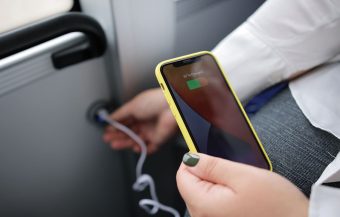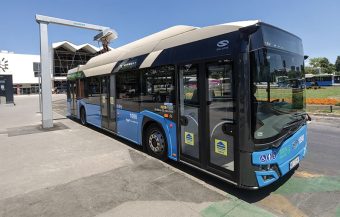
Regarding recent investments in innovation and infrastructure, Novi Sad was one of the most engaged cities in the country. The flat terrain that the city rests on has been successfully used for the development and expansion of bicycle paths, and recently, the city held a competition for the distribution of subsidies for cyclists, thanks to which there will be fewer traffic jams, plus boosts what is the healthiest and cleanest transport for people and the environment. Recently, a so-called turbo roundabout was commissioned, whereby drivers choose their direction before entering the roundabout, which should further expedite the traffic at that section. Apart from these innovations in infrastructure and traffic, starting this summer, ten new electric buses are now cruising the city, all part of the fleet owned by the Novi Sad Public City Transport Company (JGSP Novi Sad). We spoke with Apolonija Holo, Head of the Investment Maintenance Department at JGSP Novi Sad, about new buses, the company’s plans and the advantages of electric vehicles.
Q. When and how did the idea to include electric buses in public city transport develop? Have these buses replaced the oldest models that have served their time on the roads?
A. Our company’s engineers closely follow the development of the bus industry and new technologies and analyze the current market, so every new addition to the JGSP Novi Sad’s fleet follows technological achievements that ensure a higher level of safety, affordability, comfort and environmental protection. In recent years, our fleet received a hundred new CNG-powered buses, which will be discussed later. This decision is a substantial step forward.
Investing is part of Novi Sad’s larger involvement in the European Bank for Reconstruction and Development (EBRD) programme—Green Cities— which provides support to cities that want to invest in green and sustainable infrastructure, thereby solving key environmental challenges. With its Green Cities programme, the EBRD had already helped Novi Sad’s public transport to have 29 new buses as part of the ongoing fleet renewal program, when 100 new CNG-powered vehicles were purchased. This type of bus significantly reduces emissions of polluting gases, and they were purchased in 2020 and 2021.
The Novi Sad government signed a document with the European Bank for Reconstruction and Development (EBRD) in June 2020, stipulating its intentions and ambitions for purchasing electric buses. A year later, after being granted a loan with favourable terms and conditions, the procurement ensued.
The company strives to continuously renew its vehicle fleet so that a certain number of old buses are written off by purchasing new vehicles as needed.
IN FOCUS:
- THE PATH TO THE DEVELOPMENT OF E-MOBILITY
- THE TREND OF GROWING ELECTRIC CAR SALES
- ENERGY REHABILITATION CONTRIBUTES TO ENERGY SAVING AND ENVIRONMENTAL PROTECTION
Q. Could you tell us more about the performance of these buses? Which exact models did you buy, and which countries did you import them from?

A. After the public procurement was completed, we decided to go for Solaris from Poland, a company whose buses are used for public transport throughout Europe. Solaris has been repeatedly awarded for quality and innovation in Poland, as well as in other countries. At the same time, Solaris Urbino 12 electric buses, which are now part of the JGSP Novi Sad fleet, won the prestigious 2017 European Bus of the Year award.
These are low-floor, twelve-meter-long buses that can take up to 80 passengers plus the driver. In addition to the equipment that is generally standard in our vehicles (built-in air conditioning, platform for disabled passengers, cameras and video surveillance), the new buses have modern Mirror Eye mirrors. It is a set of cameras that replace conventional mirrors and show the driver the area immediately around the bus, significantly increasing traffic safety. Furthermore, they are equipped with Mobileye Shield+, a solution designed to avoid traffic accidents making driving safer. Thanks to this system that notifies the driver with sound and visual signals where pedestrians and cyclists are and how far the bus is from nearby vehicles, the problem of blind spots is solved. The buses also have a fire extinguishing system and an alcohol testing device—the vehicle’s immobilizer.

Q. How many vehicles does JGSP Novi Sad have in total? What are immediate and not-so-immediate plans regarding this type of electromobility?
A. The JGSP Novi Sad fleet currently has 276 vehicles. According to most research and the regulation being adopted worldwide, electromobility is currently apostrophized as the future of traffic. Following our capabilities and needs, we will adapt to sustainable and economical transportation trends.
Q. Could you compare the financial advantages and disadvantages of conventional buses and new electric ones?
A. Electric buses are more expensive to operate, but only in the beginning. However, the affordability goes in their favor from the moment they start using them. According to data for April 2023 (internal statistics of energy consumption and purchase prices), the cost per kilometer for diesel buses is 65 RSD/km, for CNG buses 46 RSD/km, while for electric buses it is 20 RSD/km. Furthermore, we all know that city traffic is one of the major sources of pollution and we are aware of that part of our responsibility, as companies whose vehicles travel millions of kilometers annually. By investing in a sustainable form of mobility, we will contribute to improving the quality of the environment.
Prepared by: Milica Vučković
Read the story in the new issue of the Energy portal Magazine ELECTROMOBILITY



